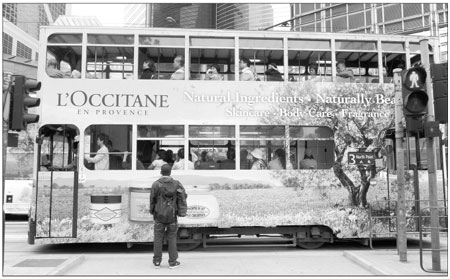L'Occitane looks to ride the coattails of developing markets
Updated: 2011-06-28 07:36
By Emma An(HK Edition)
|
|||||||||
|
A tram with L'Occitane advertising in Hong Kong. The French skincare products maker reported a 22 percent growth in annual profit. Antony Dickson / AFP |
L'Occitane International SA, the French cosmetics and skincare products maker, said on Monday its full-year net profit rose 22 percent as more stores were opened and sales grew in most of the markets where it has a presence.
In its second annual results announcement since its Hong Kong listing in April 2010, L'Occitane recorded a 22 percent year-on-year increase in net profit to 99.5 million euros ($142 million) for the year ended March 31 on sales of 772.3 million euros, 26.1 percent more than the previous year.
The board proposed to pay a dividend of 0.0135 euro per share, corresponding to a payout ratio of 20 percent.
During the financial year, L'Occitane increased the total number of retail locations to 1,828 from 1,541 a year ago, with a net addition of 131 of its own stores. Among new stores, more than 60 percent were in BRIC (Brazil, Russia, India and China) countries, including 24 on the mainland, said Andre Hoffmann, L'Occitane's managing director and executive director.
"We intend to continue with our ambitious store opening plan not only in emerging markets but also fast growing developed countries," said Hoffmann at a media briefing.
While committed to further expanding its footprint in emerging markets including China, India and Brazil, the French beauty brand will accelerate store openings in such developed markets as Germany, Spain and Italy, where sales leapt by 27 percent, 30 percent and 68 percent respectively in the year to March.
For the mainland, where L'Occitane currently owns 71 retail stores, the company plans 30 store openings in the 12 months through March 2012.
Despite making up only 4 percent of its global sales for 2011, the mainland seems poised to overtake Japan as L'Occitane's top market with its stunning growth rate, and Hoffmann acknowledged that this "could happen" despite the "big gap today".
Sales on the mainland soared 46 percent in the year to March 2011, fueled by new store openings and brisk same-store sales growth, which, at 8.3 percent, was higher than most developed markets.
In Japan, which generated a quarter of L'Occitane's overall sales, net sales rose 11 percent, while same-store sales increased 1.8 percent.
"The growth outlook for China is fantastic, and we don't see that changing in the near term," said Hoffmann.
The outlook for its number one market Japan, however, will remain unclear due to the March catastrophe, which caused disruptions to L'Occitane's business in the country in the two weeks following the event, according to Hoffmann.
But a large part of the momentum will still come within Asia Pacific. Of the 549 stores the company plans to open during the coming five years, slightly under a third will be in Asia Pacific, according to Hoffmann.
He said that the company is happy with what it has achieved in Hong Kong, where L'Occitane ran 22 stores as of March 2011.
Despite being both a heated and saturated market, as Hoffmann noted, Hong Kong led L'Occitane's same-store sales growth globally with a 20 percent gain, boosted in large measure by the growing number of mainland tourists visiting Hong Kong and spending money here.
In a research note, JPMorgan analyst Elsa Yang wrote that a good set of results together with further visibility of the company's Japan market will continue to drive the share price. The stock has lost 13 percent this year, compared with a 4.3 percent decline for the benchmark Hang Seng Index.
L'Occitane's shares slipped 0.9 percent to HK$18.62 at the close of Monday trading in Hong Kong.
emmaan@chinadailyhk.com
China Daily
(HK Edition 06/28/2011 page2)
